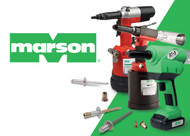What Is A Rivet And How Does It Work?
21st Feb 2024
A rivet is a small but mighty fastener used to join two pieces of material together, often metal. Unlike screws or bolts, rivets are installed by being placed into a pre-drilled hole and then deformed to hold them in place, creating a secure and permanent bond.
This simple tool has many applications, from building bridges and aeroplanes to simple home DIY projects. The beauty of a rivet lies in its simplicity and strength, providing a reliable solution for many construction and repair tasks.
Let’s take a look at how it works.
How Do Rivets Work?
Rivets are inserted into pre-drilled holes that align the materials to be joined. The tail of the clip is then deformed, often with a tool, so that it expands and locks the rivet in place. This process, called riveting, creates a tight and secure joint.
The deformation of the rivet's tail can be achieved through various methods, depending on the type of rivet used. For example, solid rivets are hammered to flatten the tail, while blind rivets use a unique tool to pull a mandrel, expanding the rivet's body and snapping off the mandrel when the proper tension is reached.
This method of fastening is especially valued for its durability and strength. Since rivets form a permanent bond, they do not loosen over time as screws might. This makes them ideal for applications where reliability is crucial, such as structural engineering or aircraft manufacturing.
Types Of Rivets
1- Solid Rivets: The Foundation of Heavy-Duty Fastening
Solid Rivets are essential for creating enduring bonds in heavy construction and manufacturing. They consist of a single piece of material inserted into a hole and deformed to secure materials together. Their robustness makes them perfect for critical structures like bridges and aircraft.
2- Blind Rivets: Versatile Fastening for Limited Access Areas
Blind Rivets, known for their ease of installation from one side, are indispensable for projects with restricted access. Comprising a hollow body and a mandrel, they expand to clamp materials tightly upon mandrel removal, which is ideal for DIY and automotive repairs.
3- Threaded Insert Rivets: Providing Removable Threads in Thin Materials
Threaded Insert Rivets offer a unique solution by adding a threaded insert into thin materials, allowing for the attachment of components with screws. These rivets are crucial in industries requiring the flexibility of assembling and disassembling parts, such as automotive and aerospace applications.
Hand Rivet vs Rivet Gun
Hand rivet tools, which require manual force, allow for direct control during the riveting process, whereas rivet guns are powered by air or electricity. They are best suited for projects requiring many rivets, where their efficiency can save considerable time and labour.
Hand rivet tools are versatile and can work in tight or awkward spaces where machinery can't reach. In contrast, while less flexible in tight spaces, rivet guns offer specialized attachments and settings to optimize the riveting process for specific types of rivets and materials.
Marson: One Stop For Quality Rivets
Marson provides a broad selection of high-quality rivets, earning trust among professionals and DIY enthusiasts alike. Their products are designed for strength and durability, essential for critical projects. They blend traditional and modern fastening techniques, innovating continuously to meet industry needs. This makes Marson a leader in providing efficient and reliable riveting solutions.
Marson Is Available At JB Tools Now!
JB Tools proudly offers Marson riveting tools at competitive prices, making premium quality accessible to all. With Marson's range now available, customers can enjoy both affordability and the exceptional customer support that JB Tools is known for. Explore our Marson selection today and experience the satisfaction.




